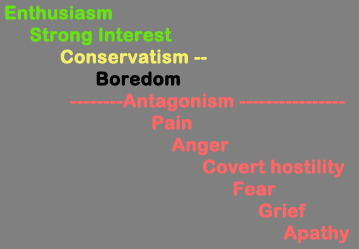The Amazing “B” Trait
The “B” Trait aligns with the emotional tone scale.
The “B” is the HAPPINESS trait at the top, and UNHAPPY at the bottom. For what it measures it could be called “Emotion” at the top and “MISemotion” at the bottom. Did you know that when this trait hits -19 on the profile scale that is the 2.0 level (antagonism) on the emotional tone scale? 0.0 on the test compares to 3.0 on the Tone Scale.
If the “B” trait goes “compulsive” – which means that it extends above the “D” trait if the “D” is +32 or above – the person must be happy. It is a “false face.” To determine the actual tone level of the person you then look at the “H” trait. It will reflect the true level. If the “H” is also compulsive, refer to the section in the Evaluator’s Manual concerning “Compulsive” traits.
Emotions are small behavior packages that are invariable and therefore highly predictable. For example, if someone is angry they are motivated by the impulses to stop and to destroy. The person in grief has lost something and shows tears. The apathetic person has very poor perception and feels that it makes no difference what they do.
The “package” of behavior for each emotion on the scale is in itself a fascinating study, but for our purposes on the “B” trait there are a few things to really understand:
- Emotions occur in a certain invariable sequence.
- The common denominator of life is motion. Whatever else life is doing, it is moving. Whether the motion of tiny atoms or galaxies, motion is everywhere and everything.
- Emotion demonstrates the tolerance for motion. Whether it be the motion of a child running through the house or a prospect blowing up in your face or the flood of perceptions that occurs when you hit your thumb with a hammer, life is moving.
- Emotions each have their own precise package of predictable characteristics.
- There are “plus emotions” which are very tolerant and there are “minus emotions” which are intolerant.”
- Emotions change according to one’s tolerance for the motion of the things being viewed. Hence, about some things you are happy and tolerant or unhappy and intolerant.
Here is an abbreviated scale of emotions that show the relationship discussed above:

- The point of Antagonism is a very important point. Above this line you find people who are more and more tolerant as they go UP. Below this point you have people who are less and less tolerant.
- The point at which a person begins to go insane is the point when he begins to STOP things. This point is ANTAGONISM on the scale. On the PerfectProfile Graph this point is at -19 on the “B” Trait scale.
- Below Antagonism we find people who want to STOP things. How they stop things changes with the emotion, but the result is always STOP.
- Above Antagonism we find Boredom. This emotion does not stop – but neither does it GO. It really doesn’t care much either way.
- Above Boredom is CONSERVATISM. This person wants to KEEP THINGS THEY WAY THEY ARE. No stop and no go – just keep it doing what it is already doing!
- ABOVE conservatism – which is at “0” on the Personal MatriX ProfileTM – you find people want to GO and make things GO.
Therefore, people who test below -19 on the B scale are stop-oriented. Some jobs are well suited for this trait. For example, someone who puts out fires on oil rigs. He really needs to STOP things! But as an executive he would destroy the group.
People above zero on the B trait are a better bet for any job. There is much more to know about this trait that is revealed in the Evaluator’s manual.
-Vulindleyla
Senior Evaluator
